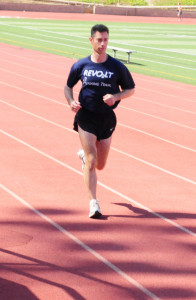I was asked today if I could share some advice in my blog about how to learn to run at the correct speed. Well, of course I can!
Most runners train haphazardly, without any real sense of purpose, and then are often disappointed with their racing results. When you train with a purpose and understand the reason for every workout, you can train more precisely and set yourself up for success. Understand the purpose for every workout you do, and then design a workout to meet the purpose. If you have a coach, ask him or her to explain the purpose of your workouts so you can become a part of the process.
Meeting the purpose of a workout is often problematic when runners of different abilities train in a group or as part of a team. I see this all the time. During an interval workout, for example, the faster runners get a lot of recovery relative to the work periods, as they wait for the slower runners to finish. The slower runners always run too fast in an attempt to keep up with the faster runners, and get less time for recovery before the start of the next work period. There may be a few runners in the middle of the group who get the optimal stimulus. In a team dynamic, unless the coach takes strict care to design the workout for each runner, using the right pace, the right duration of the work periods, and the right amount of recovery, few of the runners get an optimal workout that specifically meets the intended purpose.
Of all the workouts you do, the easy runs, which comprise the bulk of your training, are least tied to a specific pace because the volume of work done is more important than the speed at which it’s done. Many of the physiological and biochemical adaptations that you’re trying to obtain are volume-dependent, not intensity-dependent. However, you don’t want to run so slow that you don’t provide a stimulus for adaptation.
What pace should I run, Coach? Excellent question! To optimize your training, follow my pacing guidelines:
Easy Runs and Long Runs: 1½ to 2 minutes slower than 5K race pace; 65 to 75 percent max heart rate. Run slow enough that you can hold a conversation, perhaps one about how much you enjoy reading my books!
Acidosis (Lactate) Threshold Runs: About 10 to 15 seconds per mile slower than 5K race pace (or about 10K race pace) for slower, recreational runners (75 to 80 percent max heart rate); about 25 to 30 seconds per mile slower than 5K race pace (or about 15 to 20 seconds per mile slower than 10K race pace) for talented and highly-trained runners (85 to 90 percent max heart rate). The pace should feel comfortably hard.
VO2max Intervals: The speed that causes you to reach VO2max when you’re running, which is about 1- to 1½-mile race pace (about 20-25 seconds per mile faster than 5K race pace) for recreational runners and about 2-mile race pace (about 10-15 seconds per mile faster than 5K race pace) for highly-trained runners. Since VO2max is reached at 100% max heart rate, aim to reach 95 to 100% max heart rate during each work period.
Anaerobic Capacity Intervals: Fast (but not all-out) running that causes acidosis in your legs; about 400-meter to 800-meter race pace for recreational runners and 800-meter to mile race pace for trained runners. If you don’t know what your 800-meter or mile race pace is, just run fast enough that you almost feel like you’re sprinting, but not so fast that you exhaust yourself on the first one and can’t run the same pace for subsequent reps after a short recovery interval.
How do you learn to run at these paces, Coach? Another excellent question, and the one I was asked today. How do you learn to play the piano? How do you learn to cook? How do you learn calculus? You have someone teach you how to do it and then you PRACTICE.
Practice your workouts on a measured path or on a track, where you can look at your stopwatch throughout the run. For example, say you’re running mile reps at lactate threshold pace in 7:00 each. That means you should run each 400 meters in 1:45. If you run the first 400 meters in 1:40, you know you’re too fast and you need to slow down. If you run the first 400 meters in 1:50, you know you’re too slow and you need to pick up the pace. If you’re on a track, you can break this down even more into 200-meter segments or even 100-meter segments. Figure out the math before the workout so you know how fast you need to run each segment as you run around the track. Know what the stopwatch should read at the end of each lap. Over time, making constant subtle changes in pace based on the stopwatch, you’ll learn how to run at the correct pace until you can “feel” it without looking at your stopwatch.
Run workouts on the track, where your body can get in tune with pace and become a well-tuned instrument.
Thanks for the question, Eleonora! I hope this answers it!
Don’t forget to read my new e-book, Secrets of Running Injury Prevention!


Pingback: Gregg French
Pingback: Pick It Up Already and Well, It’s On